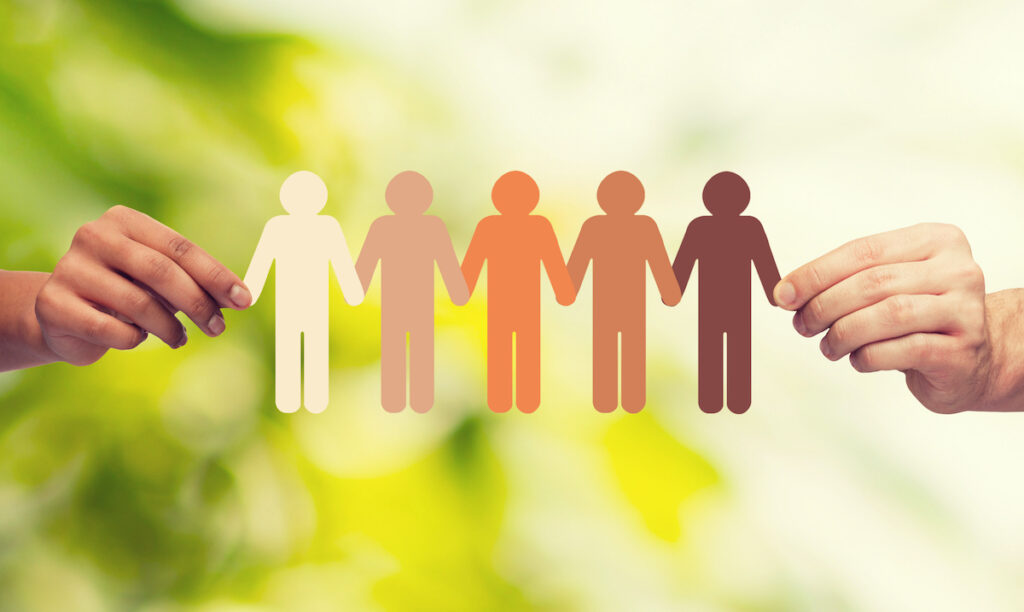
Each of us has a story to tell when it comes to how the COVID-19 pandemic has affected us. It is hard to imagine the drastic change to the way we live has not had an impact on the population’s mental health. However, it seems that some may be worse affected than others and that these differences are exacerbating pre-pandemic social inequalities.
A large population study carried out during the pandemic found self-harm, and thoughts of suicide or self-harm, were higher among women, people from minority ethnic groups, people experiencing socioeconomic disadvantage and people with pre-existing mental health problems (Iob, Steptoe & Fancourt, 2020). These findings were reinforced by a study that interviewed people with mental health problems about their experiences during the pandemic. A common theme reported was that the pandemic had impacted certain social groups unequally, including people with mental health problems and people from black and other minority ethnic groups (Gillard et al., 2021).
Understanding the impact of the pandemic on our mental health, and which groups have been worse affected, is essential for an informed approach to mental health care provision post-pandemic. This blog focusses on a study by O’Connor and colleagues (2020) which looked at how mental health and well-being changed during the first six weeks of the UK lockdown, including how it changed amongst different groups in society.

Research shows that the pandemic has impacted certain social groups unequally, including people with mental health problems and people from Black and other minority ethnic groups (Gillard et al., 2021)
Methods
A recent study led by Professor Rory O’Connor (O’Connor et al, 2020) recruited adults (aged over 18) living in the UK to complete an online survey regarding their mental health and well-being at three different waves over a six-week period at the start of the first lockdown (March-May 2020).
Members of a research panel (panelbase.net) were invited by email to participate using a quota method based on gender, age, socioeconomic status (based on occupation), and region in the UK. This meant that once a certain number from a specific group was recruited (for example, 1,500 women), the researchers stopped recruiting participants from this group.
The online panel has around 300,000 adult members, of which 7,471 were invited to participate. Members were invited to complete the survey during multiple time-points, including wave one (31 March to 9 April 2020), wave two (10 April to 27 April 2020) and wave three (28 April to 11 May 2020). Those who did not participate at wave two could still participate at wave three. Participant invitations were scheduled so that there was a gap of at least one week between the participant completing the survey at waves one and two, and three weeks between waves two and three. There were a further three waves stretching into autumn 2020 but results from these time-points were not included in this study.
The following aspects of mental health and well-being were assessed through standardised measures:
- symptoms of depression using the nine-item Patient Health Questionnaire (PHQ-9);
- symptoms of anxiety using the 7-item Generalized Anxiety Disorder (GAD-7);
- well-being was assessed using the 7-item Short Warwick Edinburgh Mental Well-Being Scale (SWEMWBS);
- feelings of defeat, described by the authors as a “perceived failed struggle and loss of rank”, were assessed using four items from Griffiths’ short-form scale;
- feelings of entrapment, whether that was feeling entrapped by thoughts and feelings or situation, were assessed using the Entrapment Scale Short-form;
- loneliness was measured using the UCLA three-item scale; and
- suicidal behaviour and ideation over the past week using two questions adapted from the Adult Psychiatric Morbidity Survey.
To explore changes in mental health over time and between different sociodemographic groups (e.g. women and men), the researchers used generalised estimating equation modelling with multiple imputation and controlled for region. Multiple imputation is a statistical technique used to handle missing data.
Results
Of the 7,471 adults invited to take part in the study, 3,077 participated. They all completed the survey at wave one, 89% (N=2,742) completed the survey again at wave two, and 85% (N=2,604) at wave three.
At wave one, around one-in-four participants had a score on the depression measure which indicates either moderate or severe depression, and one-in-five reported moderate or severe levels of anxiety. The rate of depression didn’t change over time, but levels of anxiety did decrease slightly from 21% at wave one to 17% at wave three. Feelings of defeat and entrapment also decreased over time, but the rate of loneliness stayed the same, whilst positive well-being increased. However, suicide ideation increased over time. At wave one, 8% reported having had suicidal thoughts over the last week and this increased to 10% at wave three. Reported suicide attempts and self-harm were quite low, so the researchers couldn’t test whether they statistically increased or decreased over time.
There were a number of differences between sociodemographic groups. Women, young adults (aged 18-29), those from socially disadvantaged backgrounds, and people with pre-existing mental health problems, all had worse outcomes. This was the case for all the measured outcomes, except for suicide ideation which was similar between women and men. Suicide ideation was particularly high however among younger adults with 14% aged 18 to 29 reporting suicidal thoughts over the last week at wave three, compared to 11% in those aged 30 to 59 and 3% in over 60s. There were no differences found between white and minority ethnic groups.

According to this research, suicide ideation increased over time during the Mar-May 2020 lockdown, and women, young adults, those from socially disadvantaged backgrounds, and people with pre-existing mental health problems were affected worse than others.
Conclusions
The study reports worrying levels of poor mental health and well-being among adults living in the UK during an early phase of the pandemic. The high and increasing rates of suicide ideation, particularly among young adults, is especially concerning. It also adds to the current evidence showing that some sociodemographic groups are more likely to be negatively affected by the COVID-19 pandemic than others, potentially exacerbating pre-pandemic social inequalities.

The study reports high levels of poor mental health during the first six weeks of the UK lockdown, with some groups faring worse than others.
Strengths and limitations
Rather than just a single measure of mental health, the researchers used several reliable and validated measures to explore different aspects of mental health, allowing for a better understanding of exactly how the pandemic is affecting mental health. Also, the recruitment strategy was designed in a way to try and make the sample representative of the wider population on certain characteristics. However, representativeness is still an issue.
Recruitment was carried out through an online panel. Members of this panel are incentivised to participate in research and complete online surveys for payment. Although large (around 300,000 adult members), it is not clear how representative this panel is of the wider UK population. A description of the socio-demographics of this panel, and a comparison with national figures, would go some way to addressing this issue.
Furthermore, although the researchers recognised that minority ethnic groups were more likely to have worse mental health outcomes during the pandemic, they didn’t use this characteristic in their quota sampling approach to recruitment. The sample included 292 adults from Asian, Black, mixed or other ethnic groups. This was only 10% of the full sample and was small enough that when comparing ethnicity, participants from Asian, Black, mixed or other ethnic groups had to be grouped together. This small number and grouping of minority ethnic groups may have been the reason why a difference in mental health outcomes between ethnic groups was not found in this study, but was found in previous studies.
It is challenging to recruit a representative sample, especially when recruitment is time-sensitive, has to be done online, and carried out during a pandemic. It does need to be taken into account when interpreting the results, but it doesn’t mean the results are not meaningful.

When interpreting the results from this study, the recruitment method and representativeness of the sample need to be considered.
Implications for practice
This study provides useful information about how the pandemic is affecting our mental health, and together with other research in this area, should be considered by policy-makers deciding on the plan to address this. An increase in suicide ideation (thinking), although concerning, may not necessarily lead to an increase in suicide (attempts). A recent study looking at suicide rates across multiple countries during the first few months of the pandemic found that rates did not increase (Pirkis et al., 2021). However, it is vital we remain vigilant. It is clear population mental health was badly affected at the start of the pandemic, and it remains unclear how that may continue into later phases. Something which future research should address.

When planning mental health care, policy-makers should be aware that the pandemic has worsened population mental health and increased pre-pandemic social inequalities.
Statement of interests
None.
Links
Primary paper
O’Connor R, Wetherall K, Cleare S, et al. (2020). Mental health and well-being during the COVID-19 pandemic: Longitudinal analyses of adults in the UK COVID-19 Mental Health & Wellbeing study. The British Journal of Psychiatry, 1-8. doi:10.1192/bjp.2020.212
Other references
Gillard S, Dare C, Hardy J, et al. (2021). Experiences of living with mental health problems during the COVID-19 pandemic in the UK: a coproduced, participatory qualitative interview study. Social Psychiatry Psychiatric Epidemiology.
Iob E, Steptoe A, Fancourt D (2020). Abuse, self-harm and suicidal ideation in the UK during the COVID-19 pandemic. The British Journal of Psychiatry, 217(4), 543-546.
Pirkis J, John A, Shin S, et al (2021). Suicide trends in the early months of the COVID-19 pandemic: an interrupted time-series analysis of preliminary data from 21 countries. The Lancet Psychiatry.
Photo credits
- Photo by Sam Moqadam on Unsplash
- Photo by Cody Pulliam on Unsplash
- Photo by engin akyurt on Unsplash
